Abstract
Oral midazolam is being used for conscious sedation in dentistry with little documentation assessing its efficacy. In order to accumulate preliminary data, a randomized, double-blind, controlled, crossover, multi-site pilot study was conducted. The objective was to determine if 0.6 mg/kg of oral midazolam was an equally effective or superior means of achieving conscious sedation in the uncooperative pediatric dental patient, compared with a commonly used agent, 50 mg/kg of oral chloral hydrate. Twenty-three children in three clinics who required dentistry with local anesthetic and were determined to exhibit behavior rated as "negative" or "definitely negative" based on the Frankl scale were assessed. They were evaluated with respect to acceptance of medication; initial level of anxiety at each appointment; level of sedation prior to and acceptance of local anesthetic; movement and crying during the procedure; and overall behavior. The results showed that the group randomly assigned to receive midazolam had a significantly greater initial level of anxiety for that appointment (P < 0.02), a finding that could clearly confound further determination of the efficacy of these drugs. Patients given oral midazolam had an increased level of sedation prior to the administration of local anesthetic compared with those given chloral hydrate (P < 0.015). No statistically significant differences were noted in any of the other parameters. The age of the patient was found to have no correlation with the difference in overall behavior (r = -0.09). These preliminary data warrant further clinical trials.
Full text
PDF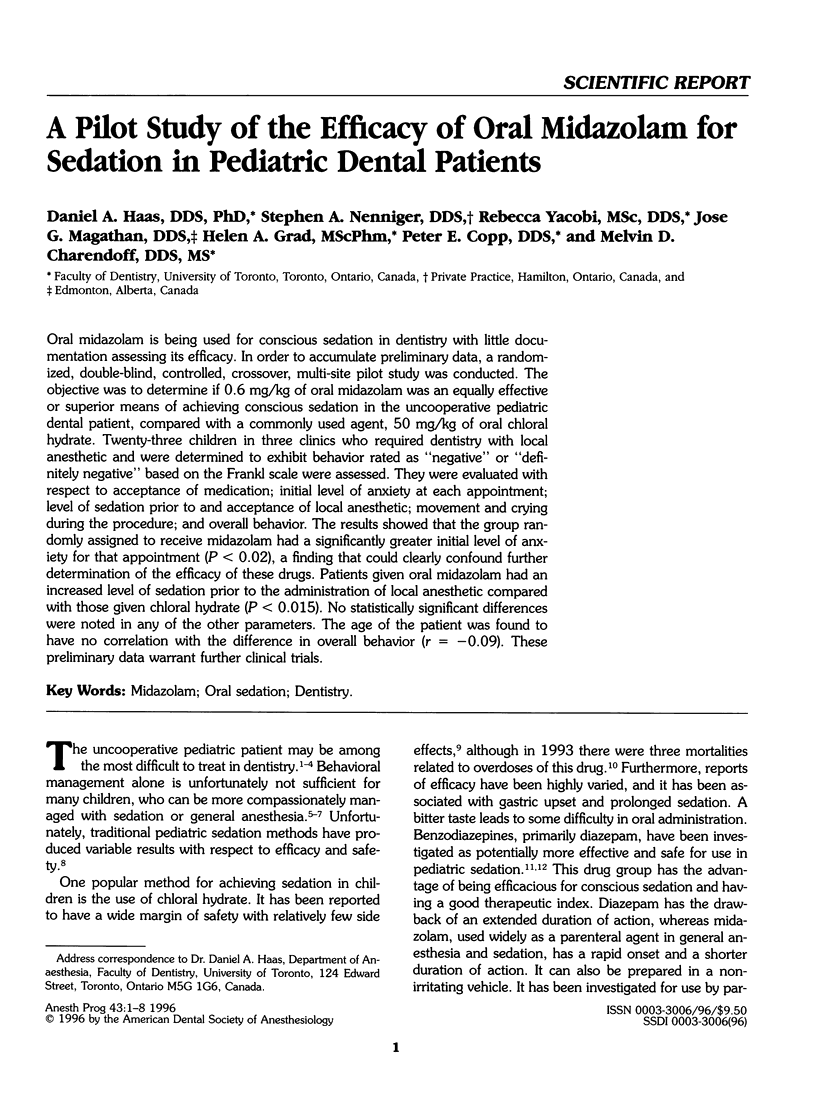

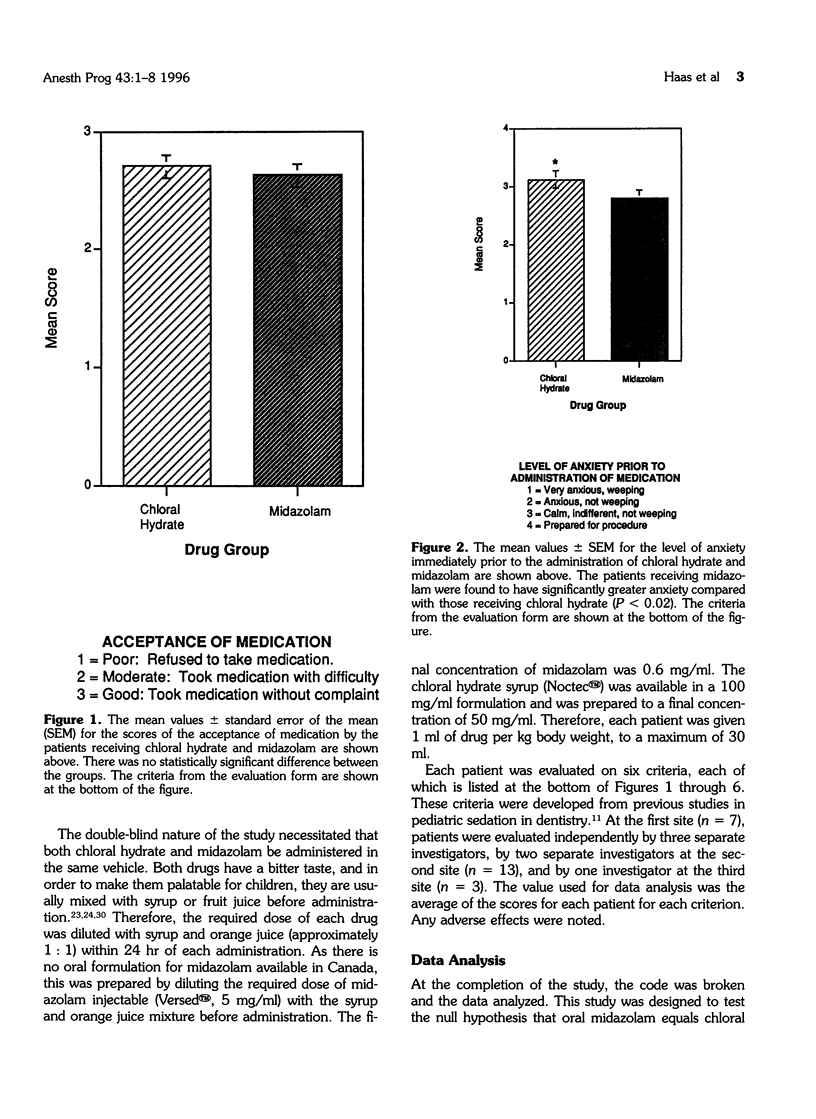
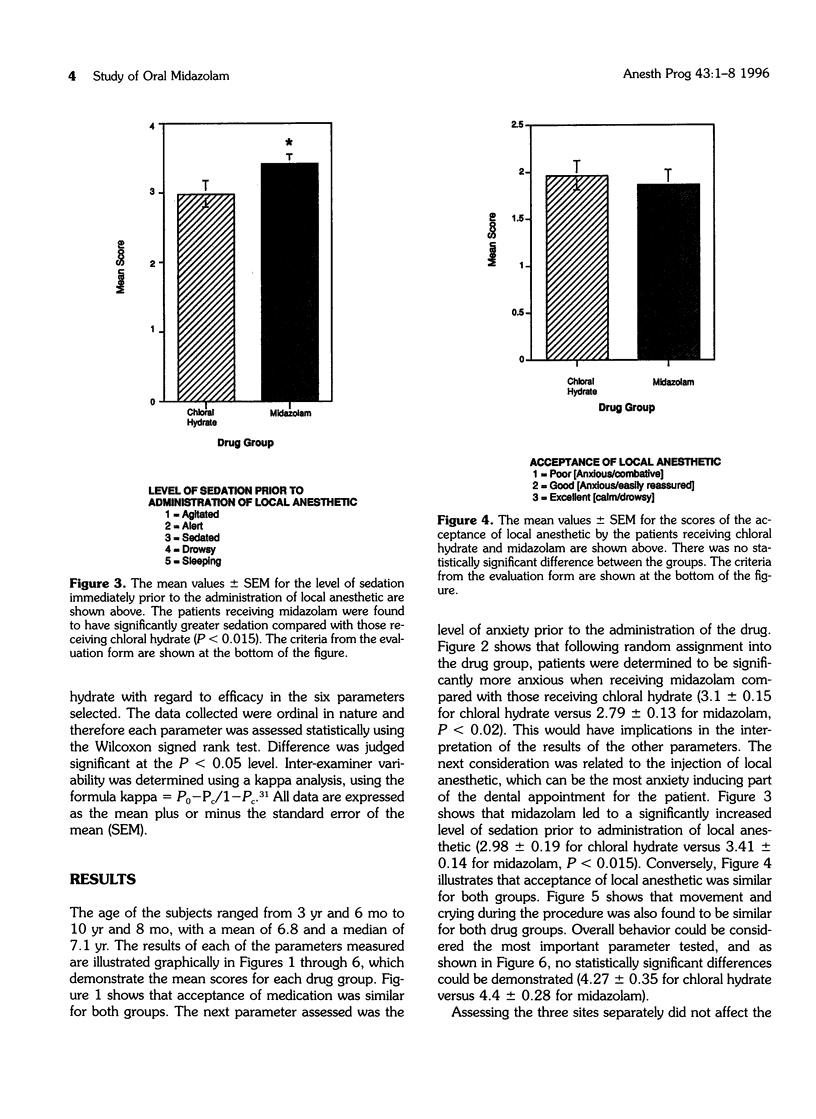
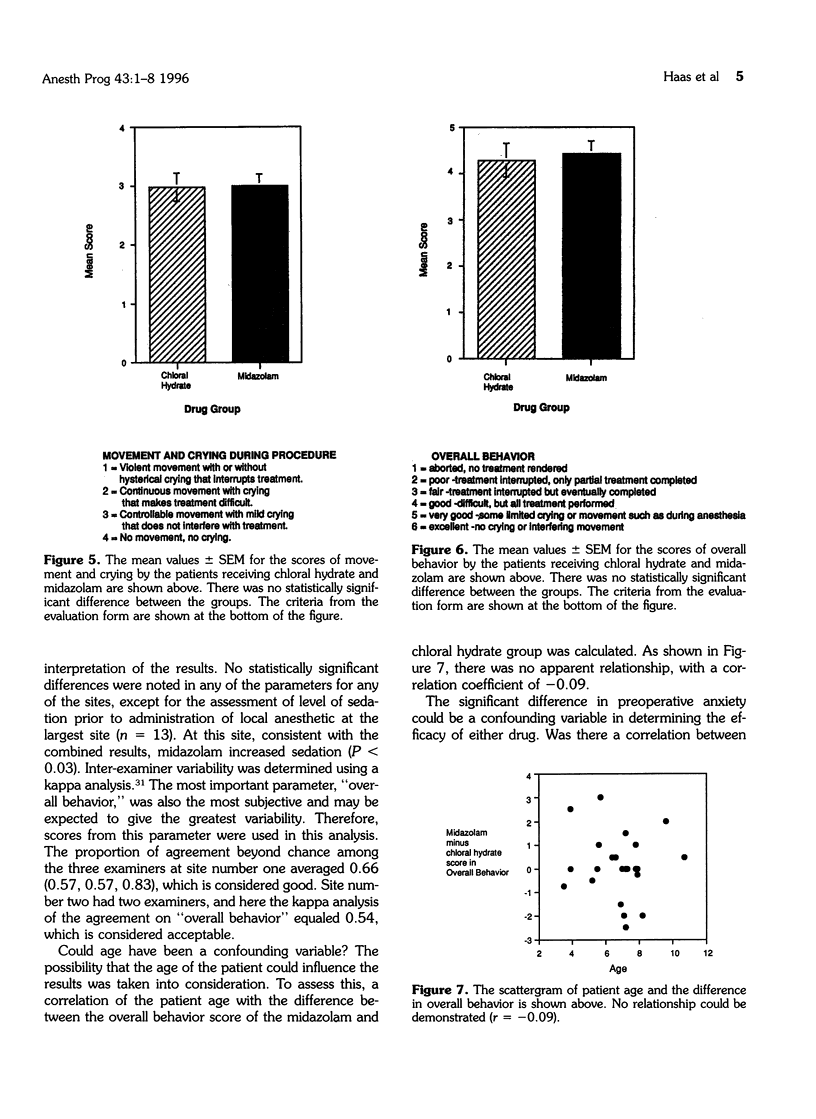
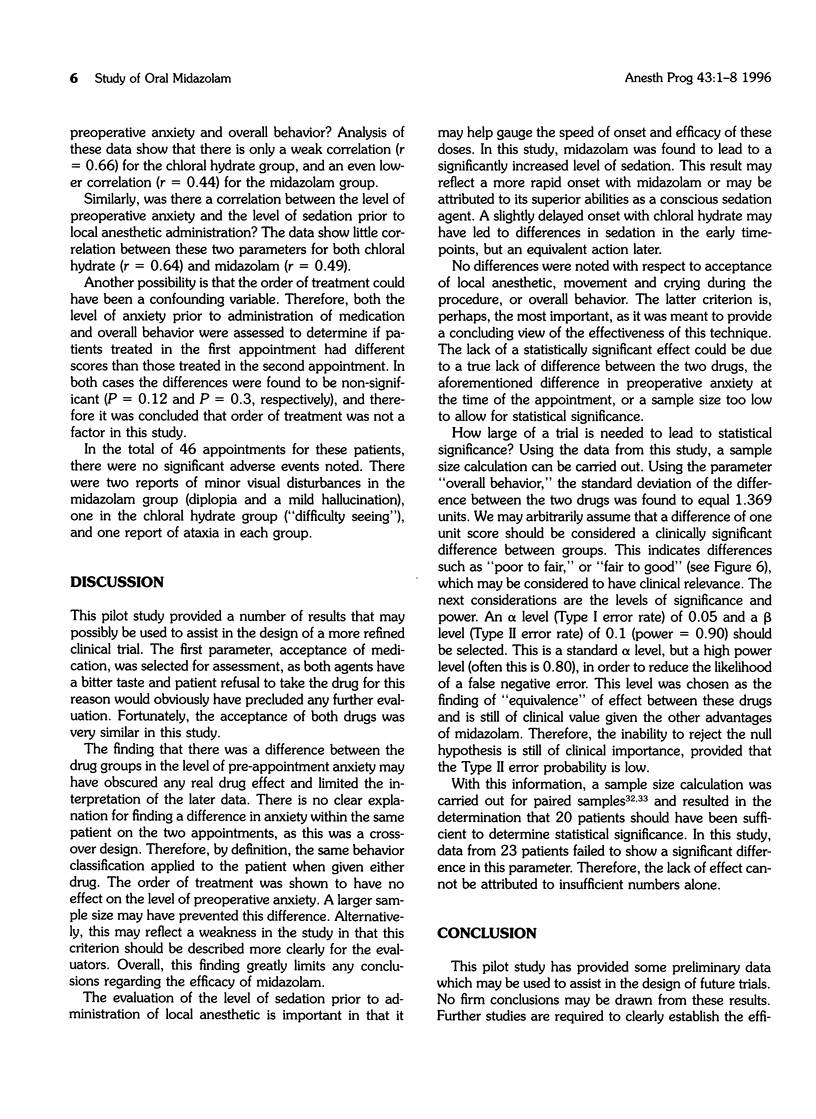
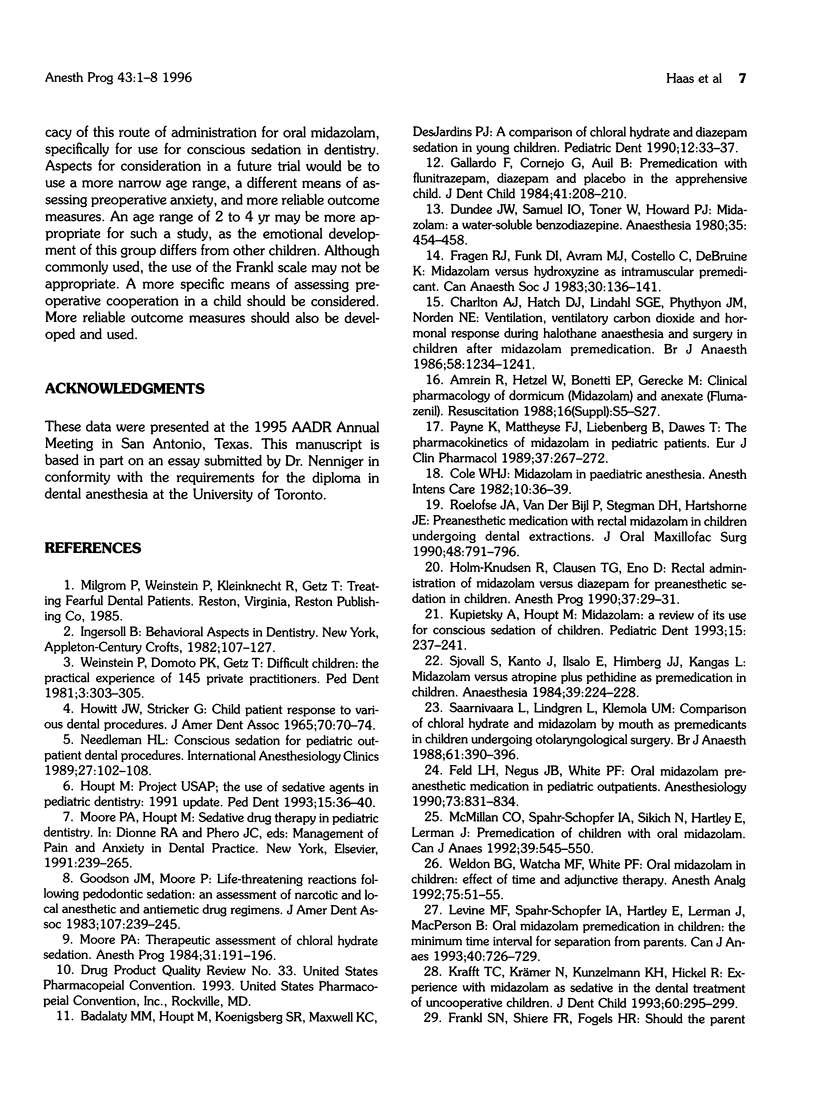
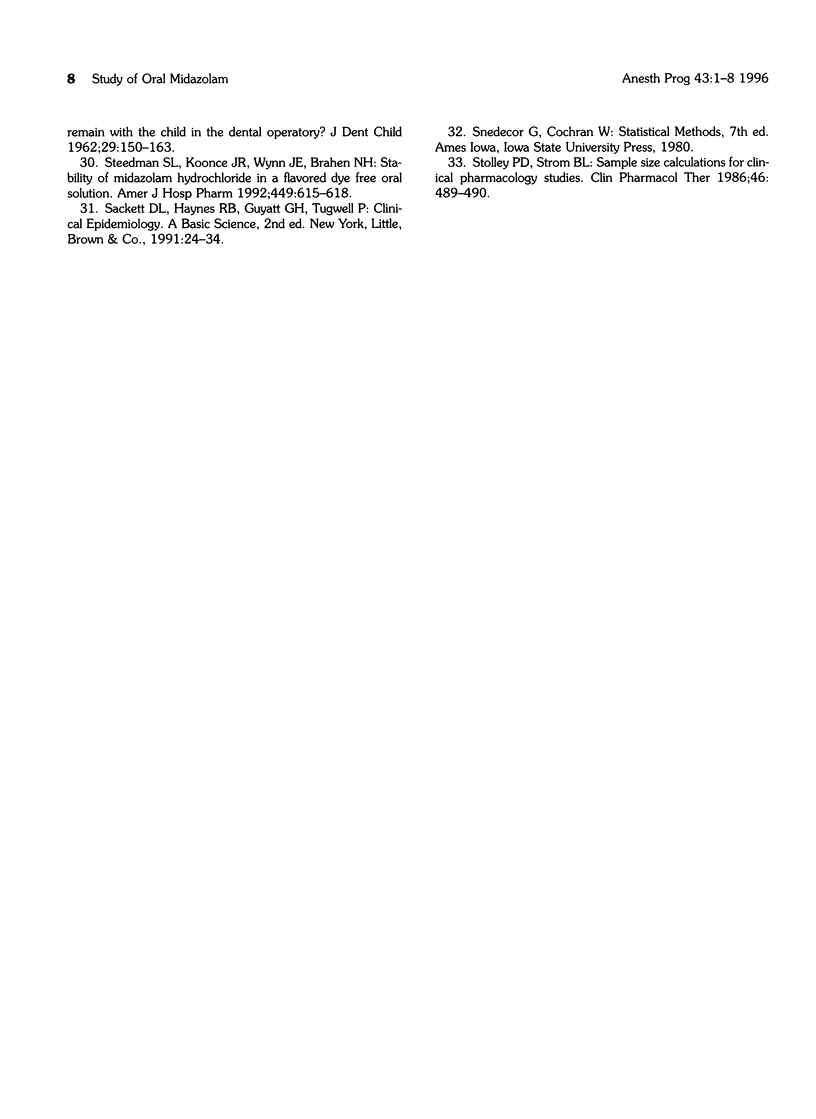
Selected References
These references are in PubMed. This may not be the complete list of references from this article.
- Amrein R., Hetzel W., Bonetti E. P., Gerecke M. Clinical pharmacology of dormicum (midazolam) and anexate (flumazenil). Resuscitation. 1988;16 (Suppl):S5–27. doi: 10.1016/0300-9572(88)90002-0. [DOI] [PubMed] [Google Scholar]
- Badalaty M. M., Houpt M. I., Koenigsberg S. R., Maxwell K. C., DesJardins P. J. A comparison of chloral hydrate and diazepam sedation in young children. Pediatr Dent. 1990 Feb;12(1):33–37. [PubMed] [Google Scholar]
- Charlton A. J., Hatch D. J., Lindahl S. G., Phythyon J. M., Nordén N. E. Ventilation, ventilatory carbon dioxide and hormonal response during halothane anaesthesia and surgery in children after midazolam premedication. Br J Anaesth. 1986 Nov;58(11):1234–1241. doi: 10.1093/bja/58.11.1234. [DOI] [PubMed] [Google Scholar]
- Cole W. H. Midazolam in paediatric anaesthesia. Anaesth Intensive Care. 1982 Feb;10(1):36–39. doi: 10.1177/0310057X8201000108. [DOI] [PubMed] [Google Scholar]
- Dundee J. W., Samuel I. O., Toner W., Howard P. J. Midazolam: a water-soluble benzodiazepine. Studies in volunteers. Anaesthesia. 1980 May;35(5):454–458. doi: 10.1111/j.1365-2044.1980.tb03821.x. [DOI] [PubMed] [Google Scholar]
- Feld L. H., Negus J. B., White P. F. Oral midazolam preanesthetic medication in pediatric outpatients. Anesthesiology. 1990 Nov;73(5):831–834. doi: 10.1097/00000542-199011000-00006. [DOI] [PubMed] [Google Scholar]
- Fragen R. J., Funk D. I., Avram M. J., Costello C., DeBruine K. Midazolam versus hydroxyzine as intramuscular premedicant. Can Anaesth Soc J. 1983 Mar;30(2):136–141. doi: 10.1007/BF03009342. [DOI] [PubMed] [Google Scholar]
- Gallardo F., Cornejo G., Auil B. Premedication with flunitrazepam, diazepam and placebo in the apprehensive child. ASDC J Dent Child. 1984 May-Jun;51(3):208–210. [PubMed] [Google Scholar]
- Goodson J. M., Moore P. A. Life-threatening reactions after pedodontic sedation: an assessment of narcotic, local anesthetic, and antiemetic drug interaction. J Am Dent Assoc. 1983 Aug;107(2):239–245. doi: 10.14219/jada.archive.1983.0225. [DOI] [PubMed] [Google Scholar]
- HOWITT J. W., STRICKER G. CHILD PATIENT RESPONSE TO VARIOUS DENTAL PROCEDURES. J Am Dent Assoc. 1965 Jan;70:70–74. doi: 10.14219/jada.archive.1965.0324. [DOI] [PubMed] [Google Scholar]
- Holm-Knudsen R., Clausen T. G., Enø D. Rectal administration of midazolam versus diazepam for preanesthetic sedation in children. Anesth Prog. 1990 Jan-Feb;37(1):29–31. [PMC free article] [PubMed] [Google Scholar]
- Houpt M. Project USAP the use of sedative agents in pediatric dentistry: 1991 update. Pediatr Dent. 1993 Jan-Feb;15(1):36–40. [PubMed] [Google Scholar]
- Krafft T. C., Krämer N., Kunzelmann K. H., Hickel R. Experience with midazolam as sedative in the dental treatment of uncooperative children. ASDC J Dent Child. 1993 Jul-Oct;60(4-5):295–299. [PubMed] [Google Scholar]
- Kupietzky A., Houpt M. I. Midazolam: a review of its use for conscious sedation of children. Pediatr Dent. 1993 Jul-Aug;15(4):237–241. [PubMed] [Google Scholar]
- Levine M. F., Spahr-Schopfer I. A., Hartley E., Lerman J., MacPherson B. Oral midazolam premedication in children: the minimum time interval for separation from parents. Can J Anaesth. 1993 Aug;40(8):726–729. doi: 10.1007/BF03009769. [DOI] [PubMed] [Google Scholar]
- McMillan C. O., Spahr-Schopfer I. A., Sikich N., Hartley E., Lerman J. Premedication of children with oral midazolam. Can J Anaesth. 1992 Jul;39(6):545–550. doi: 10.1007/BF03008315. [DOI] [PubMed] [Google Scholar]
- Moore P. A. Therapeutic assessment of chloral hydrate premedication for pediatric dentistry. Anesth Prog. 1984 Sep-Oct;31(5):191–196. [PMC free article] [PubMed] [Google Scholar]
- Needleman H. L. Conscious sedation for pediatric outpatient dental procedures. Int Anesthesiol Clin. 1989 Summer;27(2):102–108. doi: 10.1097/00004311-198902720-00007. [DOI] [PubMed] [Google Scholar]
- Payne K., Mattheyse F. J., Liebenberg D., Dawes T. The pharmacokinetics of midazolam in paediatric patients. Eur J Clin Pharmacol. 1989;37(3):267–272. doi: 10.1007/BF00679782. [DOI] [PubMed] [Google Scholar]
- Roelofse J. A., van der Bijl P., Stegmann D. H., Hartshorne J. E. Preanesthetic medication with rectal midazolam in children undergoing dental extractions. J Oral Maxillofac Surg. 1990 Aug;48(8):791–797. doi: 10.1016/0278-2391(90)90333-w. [DOI] [PubMed] [Google Scholar]
- Saarnivaara L., Lindgren L., Klemola U. M. Comparison of chloral hydrate and midazolam by mouth as premedicants in children undergoing otolaryngological surgery. Br J Anaesth. 1988 Oct;61(4):390–396. doi: 10.1093/bja/61.4.390. [DOI] [PubMed] [Google Scholar]
- Sjövall S., Kanto J., Iisalo E., Himberg J. J., Kangas L. Midazolam versus atropine plus pethidine as premedication in children. Anaesthesia. 1984 Mar;39(3):224–228. doi: 10.1111/j.1365-2044.1984.tb07231.x. [DOI] [PubMed] [Google Scholar]
- Steedman S. L., Koonce J. R., Wynn J. E., Brahen N. H. Stability of midazolam hydrochloride in a flavored, dye-free oral solution. Am J Hosp Pharm. 1992 Mar;49(3):615–618. [PubMed] [Google Scholar]
- Stolley P. D., Strom B. L. Sample size calculations for clinical pharmacology studies. Clin Pharmacol Ther. 1986 May;39(5):489–490. doi: 10.1038/clpt.1986.85. [DOI] [PubMed] [Google Scholar]
- Weinstein P., Domoto P. K., Getz T. Difficult children: the practical experience of 145 private practitioners. Pediatr Dent. 1981 Dec;3(4):303–305. [PubMed] [Google Scholar]
- Weldon B. C., Watcha M. F., White P. F. Oral midazolam in children: effect of time and adjunctive therapy. Anesth Analg. 1992 Jul;75(1):51–55. doi: 10.1213/00000539-199207000-00010. [DOI] [PubMed] [Google Scholar]


